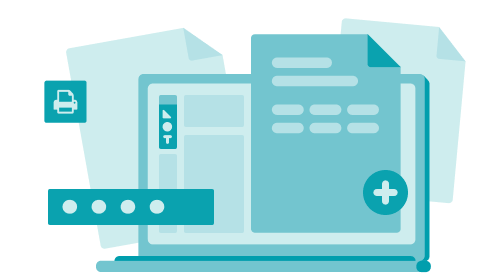You’ve probably sent or received invoices and bills over the course of running your business, but are you using these terms correctly? Although many treat “bill” and “invoice” as synonymous, they are actually distinctly different forms of commercial documentation that serve different roles in the collection of payment for products and services.
What is an Invoice?
An invoice is a document sent to a customer or client to request payment, that acts as a record of work performed and payment received. An invoice may be sent before or after work is performed depending on the agreement between the involved parties, and must detail a specific date by which payment is due.
What Does an Invoice Include?
An invoice must include these essential elements:
- The word “invoice”
- Invoice date (the date the invoice was sent)
- Due date (the date payment is due)
- A unique invoice number
- Your contact information
- Recipient’s contact information
- Description of goods and/or services
- Payment terms (amount, net terms, how to pay)
Invoicing is most commonly used by service providers to professionally request payment from clients and make accounting and financial reporting easier. Because it requires a greater level of detail than a bill, it’s best to use a consistent invoice template for your invoicing to create a cohesive experience.
What is a Bill?
The ultimate purpose of a bill is to serve as legal evidence for both parties that a sales transaction took place, as well as to request payment that is immediately due. Similar to an invoice, a bill outlines the total payment due for goods received and services rendered, but with the expectation of immediate fulfillment rather than payment at a later date. Bills are most commonly used by restaurants, salons, retail stores, and other brick-and-mortar businesses.
What does a bill include?
Because the primary goal of a bill is to collect payment immediately, it doesn’t require the same level of detail as an invoice. A bill should briefly list the products or services purchased, their cost, and the total amount including any applicable taxes.
Bill vs. Invoice: What’s the Difference?
You may send and receive both invoices and bills, but they are different forms of commercial documentation that serve different roles in your business. The primary difference is in the payment fulfillment expectations: Whereas an invoice identifies a future date by which payment is due, a bill is intended for immediate payment. Bills are used for one-time transactions and mainly detail information regarding pricing and taxation. Invoices, however, may be used for one-time or recurring transactions and require further detail about the sender and the recipient.
Here’s a quick guide to help you distinguish between a bill and an invoice:
| Invoice | Bill |
|---|---|
| Payment due at a later date | Payment due immediately |
| Can be one-time or recurring | Used for one-time transactions |
| Used by both parties for financial reporting, accounting, and tax purposes | Serves as legal documentation for proof of transaction |
| May be issued before or after work is completed | For goods and/or services received |
| Requires a number of details regarding the sender, receiver, descriptions of products or services, payment information, and a unique invoice number | Only requires payment details, such as pricing and taxation |
It’s also worth noting that as the recipient of an invoice, you will identify the invoice as a “bill” in your business budget. This is a slightly different use of the term “bill” than what we are referring to here.
An Invoice or a Bill: When to Use Each
When determining which form of payment request is right for your business, it ultimately depends on the type of business you are running. Bills are best for one-time, in-person transactions where you can expect to collect payment immediately upon provision of goods or services. For example, a restaurant will provide a bill to customers at the end of their meal, which the customer then pays immediately before leaving the restaurant. A hair salon will provide a bill after the hair styling service is completed, and the customer is expected to pay before exiting the salon.
When billing a customer, you should have a means of collecting payment readily available. In some cases this might be cash only, but most businesses that expect to bill clients should have some form of card processing available as well.
An invoice, however, treats the request for payment as a form of credit. It identifies the total amount due, but with the understanding that payment will be submitted at a later defined date. Invoicing is most frequently used for services, but may also be sent for goods. An invoice can also be recurring, such as a monthly retainer for a virtual assistant or copywriter.
When invoicing a client, your invoice should detail instructions for submitting payment. This may be done by setting up direct deposit with recurring clients or by accepting multiple payment methods with invoicing software.





